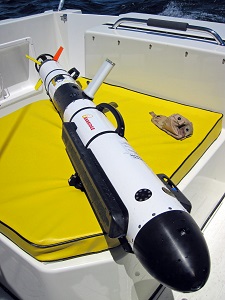Boosting safety below the surface in the Straits of Mackinac
Enbridge, Michigan Tech team up to test Autonomous Underwater Vehicle's inspection chops
It’s another tool – no, make that a sophisticated, underwater, sonar-equipped tool – in our Straits of Mackinac pipeline safety toolbox.
After more than 60 years of operation, Enbridge’s Line 5 Straits of Mackinac crossing remains in excellent condition, and has never experienced a leak.

Enbridge and Michigan Technological University have partnered to test the capabilities of an Autonomous Underwater Vehicle (AUV) in supporting our pipeline integrity management program in Michigan's Straits of Mackinac.
Still, Enbridge maintains a relentless focus on safety. That’s why we’ve acquired the most advanced, commercially available Autonomous Underwater Vehicle (AUV) on the market – and, in partnership with Houghton-based Michigan Technological University, are further enhancing this AUV to test its capabilities in supporting our pipeline integrity management program.
Enbridge’s AUV, about 4.5 feet in length, will be used to collect sonar images to map the bottom of the Straits of Mackinac near the Line 5 crossings – and potentially using the information on a seasonal and year-over-year basis as an added measure of security.
“Michigan Tech and Enbridge have taken an important step forward in advanced underwater sensing of submerged infrastructure,” says Dr. Guy Meadows, director of Michigan Tech’s Great Lakes Research Center. “This project’s AUV, the IVER 3, has successfully transited and sonar-imaged the bottom of the Straits of Mackinac from north to south, and again from south to north, in less than a day.
“This new advanced technology will allow better, faster, and more efficient bottom recognizance with ultra-high resolution.”
AUVs are used to conduct surveys of underwater structures, using a pre-programmed set of instructions. In this case, project team members from Michigan Tech and Enbridge are planning to conduct four survey missions per year with the Line 5 Straits of Mackinac AUV.
“We’ll be taking the data, and comparing it with existing pipeline integrity information that’s collected regularly,” says David Hoffman, Senior Manager of Research and Development with Enbridge. “We carried out our most recent test in June, and another test is scheduled for August.”
Enbridge’s Line 5 runs from Superior, Wisconsin to Sarnia, Ontario, a distance of 645 miles, traversing Michigan’s Upper and Lower Peninsulas. As it reaches the Straits of Mackinac, the line splits into two, 20-inch-diameter, parallel pipelines buried onshore and tapering off deep underwater – crossing the Straits of Mackinac west of the Mackinac Bridge for a distance of 4.6 miles.
We’ve taken special care and attention with this particular section of pipeline, right from its design and construction in 1953 to our industry-leading operations and monitoring programs – which use both human resources and cutting-edge technology to provide multiple layers of protection.
Some of those precautions with the Line 5 Straits of Mackinac crossing include:
- Increased inline inspections with sophisticated tools, which provide a level of detail similar to that provided by MRIs, ultrasound, and X-ray technology;
- Regular inspections using expert divers and Remote Operating Vehicles (ROVs), which provide a thorough look at the pipe’s exterior and its immediate environment;
- A robust coating material that effectively prevents corrosion, and a low-stress operational environment;
- A depth-of-entry point into the water that protects the line from moving ice packs and other potential damage.
“This AUV that we’re testing with Michigan Tech may prove to be a very useful tool in supporting the integrity management of Enbridge’s pipelines,” says Hoffman.








